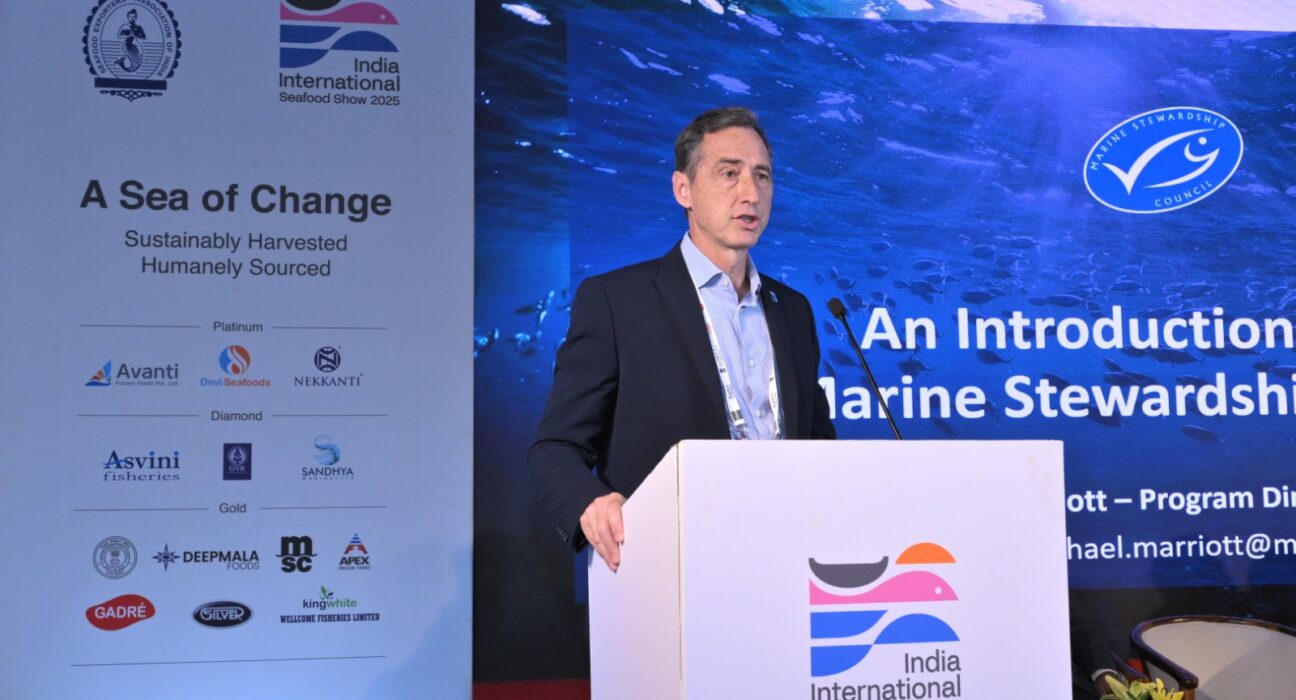This is an interview with Michael Marriott, Program Director for Africa, the Middle East, and South Asia at the Marine Stewardship Council (MSC). Michael was a key speaker at a recent technical session in New Delhi during World Food India, jointly organized by MSC, the Sustainable Seafood Network India (SSNI), and the Seafood Exporters Association of India (SEAI).
Can you summarise the scale of the challenge and why sustainability is now an urgent economic issue?
The scale is immense, and the economic urgency cannot be overstated. Global seafood consumption has skyrocketed from 28 million tonnes in 1961 to 158 million tonnes in 2019, with a further 15% increase projected by 2030. However, this demand growth is running directly into a supply wall:
over 30% of global fish stocks are currently fished beyond biologically sustainable limits, a figure that has tripled since 1974.
For India, a major global seafood exporter, the market risks must be considered: unsustainable practices lead to stock collapse, regulatory actions, and exclusion from major import markets. Conversely, if all wild-capture fisheries globally were sustainably managed, they would generate 16 million tonnes more catch annually, resulting in a potential net ocean benefit of US$88.9 billion per year. Sustainability is therefore the only model for long-term supply security and economic growth.
In the context of India’s robust seafood export industry, what is the clear business case for a fishery to invest in MSC certification? What is the tangible return on investment?
The return on investment is primarily about securing and accessing premium international markets. The MSC approach is designed to transform the market by recognizing and rewarding sustainable fishing.
The tangible business benefits include possible market access and security, enhanced reputation, and operational improvement. Certification supports access to new and secure markets where major retailers and buyers—particularly in Europe and North America—have made explicit commitments to preferential sourcing MSC-certified products. Certification confirms the fishery is well-managed, sustaining resources and livelihoods for future generations, which builds trust with international buyers and stakeholders.
This process itself acts as a pathway for improvements, leading to better resource management and more abundant stocks. Our data shows MSC-certified stocks are more abundant overall than non-certified ones.
You mentioned the power of the consumer. How significant is the global demand for certified sustainable seafood, and which regions are driving this demand?
Consumer demand is the engine driving this transformation. The global market for MSC-labelled seafood products is substantial: we currently have over 20,910 products carrying the blue MSC label across 66 nations. This market generates a retail sales value of US$12.4 billion, with a wholesale value of £7.8 billion (2023-2024).
The bulk of this demand comes from key importing regions, with Germany (DACH), the US & Canada, and the UK/Ireland leading the volume of MSC-labelled sales. Our 2024 GlobeScan survey indicates that concern for the ocean is increasing among consumers, and significant numbers are actively re-appraising their dietary choices to move toward healthier, sustainable proteins. Businesses that certify are simply responding to this powerful, non-negotiable consumer shift.
India’s MSC journey is in progress, with the Ashtamudi clam fishery previously certified and several others, like high-value shrimp and tuna, in Fishery Improvement Projects (FIPs). How important are these FIPs in preparing Indian fisheries for the final certification step?
FIPs are a valuable improvement tool, especially in a country with the scale and diversity of India’s fisheries. For many developing-world fisheries, moving directly to certification can be a long journey. FIPs provide a structured, science-based, and step-wise approach that helps to guide the necessary ecological and management changes.
They can also be a demonstration of commitment, showing the international marketplace that the fishery is interested in meeting the rigorous MSC standards for sustainable stock levels, minimizing environmental impact, and having effective management systems. This can help fisheries and supply chain partners to start to develop market partnerships as they look towards future certification.
Finally, what is your closing message to Indian fisheries stakeholders on leveraging MSC certification to maximize India’s export potential?
My message is that the time to act is now. MSC certification is the most credible tool available to future-proof the sector. By embracing the MSC standards, India’s fisheries can guarantee supply, maintain competitive edge, and drive positive change. The Certification ensures that the valuable stocks remain healthy and productive, securing the livelihoods of the 600 million people dependent on fisheries and aquaculture activities around the globe.
It will provide the assurance of sustainability and supply chain assurance that major global buyers demand, locking in preferential access to the world’s most lucrative markets.
The commitment to the MSC programme not only benefits the bottom line but also safeguards the ocean, allowing the seafood sector to align with global environmental goals and become a leader in responsible resource management.


